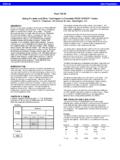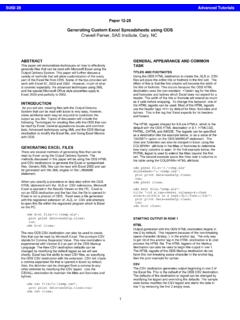Transcription of 080-2010: Using Data Set Labels and Format Descriptions to ...
1 SAS Global Forum 2010 Coders' Corner Paper 080-2010. Using Data Set Labels and Format Descriptions to simplify Application debugging Rob Russell, The Hartford, Hartford, CT. ABSTRACT. Hansel and Gretel left breadcrumbs as they wandered through the forest to leave themselves a trail back home. This paper will show you simple ways to leave pointers for yourself in SAS data sets and SAS. formats that will help you get back home when you are trying to trace a problem back through various programs. The advantage of these pointers vs. breadcrumbs is that these pointers won't be eaten by birds. INTRODUCTION. You have a production problem to debug. Where do you start your debugging efforts? In simple applications where all of the processing is contained in a single program, deciding where to start may not be that difficult. In larger, more complex and modularized applications , tracing back to the source(s) of a problem can be significantly more challenging.
2 Fortunately, there are some simple ways that you can help yourself by setting up some pointers in your application that will help you trace backwards in your application. An analogy for the techniques presented in this paper is what Hansel and Gretel did in the Grimm Brothers' story. When Hansel and Gretel went into the woods, they left a trail of bread crumbs behind so they could find their way back home (ignore that fact that the birds ate the crumbs). We will leave a trail . or more accurately, pointers - from our data sets and formats back to their creating programs. The techniques that we'll look at are: Use data set Labels to point back to the programs that created them;. Use catalog Descriptions on SAS formats to point back to the programs that created them; and, Include a production date in the SAS data set label as a simple means of dating the file. Note for purposes of this paper, the term pointers will be used to refer to both data set Labels and SAS.
3 Format catalog Descriptions . WHY DO THIS? Why go to the effort of creating these pointers? The answer is, quite simply, because the information contained in the pointers makes it easier to debug problems. By creating these pointers, you are adding metadata (information about the data) to the data itself. We are all used to Using some common types of metadata file size in megabytes, number of observations in a SAS data set or whether or not the SAS. data set is indexed. If you know what program created a data set or Format , you have a direct path back to the most likely place to look for a problem. The ultimate cause of a problem will frequently be somewhere other than the program that created the data set or Format , however knowing where to start looking for the problem definitely saves time. Size does matter. Our application is comprised of hundreds of SAS programs, hundreds of permanent formats (used as mapping tables) and thousands of data sets.
4 While our application isn't that large, it would be a rare programmer who could remember all of the relationships between these objects. The pointers are a debugging aid and are also an excellent tool for new programmers in the area when they need to trace data flows through various aspects of our application. A key point about these techniques is that you must make the effort up front to create these pointers. You can't decide that you want to retroactively create the pointers when you suddenly have a production problem to debug. It doesn't take much time or code to create the pointers. The most difficult aspect of 1. SAS Global Forum 2010 Coders' Corner creating the pointers is training yourself to make that creation an automatic part of the code that you write. When you type DATA data set name , automatically think of the DATA statement as being DATA data set name (label= my label ). When you create a new Format that will be permanently stored in your SAS.
5 Format catalog, think about the description that you will put on the Format . CREATING DATA SET Labels . Creating a SAS data set label is simply a matter of including the SAS data set LABEL option statement in your SAS code. The LABEL option can be added to any SAS data set that you are creating. The syntax for the data set LABEL option is (LABEL= data set label ). The descriptive label can be up to 40 characters long in SAS V6, 256 characters in V8 and higher. Following are some code examples of the LABEL option added to a few different snippets of SAS code. One comment about the SAS code examples in this paper most of the macro code is removed for purposes of clarity. For example, the date shown in the following code would really be a macro variable so that the appropriate production date for that cycle would be automatically inserted into the label. /* Example of a data set label added to a DATA step. */. DATA (label= SB0007PC: Full AYR 200912 Homeowners ).
6 Set ;. run;. /* Example of a data set label added to a PROC SORT. */. PROC SORT. data= out= (label= SB0007PC: Full AYR 200912 Homeowners ). nodupkey;. by VAR1 VAR2;. run;. /* Example of a data set label added to a PROC SQL. */. PROC SQL;. create table (label= SB0007PC: Full AYR 200912 Homeowners ). as select * from ;. run;. quit;. You can also run the DATASETS procedure to add a label to your SAS data set. Here's an example of that code. /* Example of a PROC DATASETS to add a label to a data set. */. PROC DATASETS ddname=RESRVSRC nolist;. modify XB2020Y0 (label= SB0007PC: Full AYR 200912 Homeowners );. run;. quit;. ADDING Descriptions TO SAS FORMATS. If you issue a CATalog command against a SAS Format catalog or dump said catalog via the CATALOG. procedure, you will see the description associated with each catalog entry. In the case of SAS formats, the Format procedure creates a description for each Format ( MAXLEN = . ). That description has never been particularly useful to us.
7 Unfortunately, there is no LABEL= or DESCRIPTION= option for PROC Format . PROC Format does not give you any way to replace that MAXLEN= description with something more useful. 2. SAS Global Forum 2010 Coders' Corner PROC CATALOG, however, does give you a way to update the description on an entry in a catalog. This technique works perfectly well against formats in Format catalogs. After the Format is created, use the MODIFY statement to update the description on the catalog entry ( Format ). The description is limited to 40 characters in SAS V6, 256 characters in V8 and higher. Following is an example of the PROC CATALOG code to update the description on a Format . /* Run PROC CATALOG to add a description to a Format . */. PROC CATALOG catalog= ;. modify description="SB8002FV-Table K: Claim Symbol Descrip");. run;. quit;. Note that the MODIFY statement needs to identify both the Format name and type. The type will be either Format or FORMATC , respectively, for numeric or character formats.
8 How do we use this technique? We simply embed a PROC CATALOG step after PROC Format in the programs that create our permanent formats. An example of that code follows. %put **;. %put Create Claim Symbol Description Format ;. %put **;. /* Read table to form CNTLIN data set. */. DATA SB8002D1 (keep=FMTNAME START LABEL);. length LABEL $30;. array ROLLUP(*) $2 RSUF1-RSUF4;. set & ;. START=CLMSYMBL;. FMTNAME="$CSYMNAM";. LABEL=CSYMNAME;. output;. return;. run;. %put **;. /* Sort CNTLIN data set into Format sort order. */. PROC SORT data=SB8002D1;. by FMTNAME LABEL;. run;. %put **;. /* Build Format . */. PROC Format cntlin=SB8002D1 library= . RUN;. %put **;. /* Add Description to Format . */. PROC CATALOG catalog=& ;. modify (description="SB8002FV-Table K: Claim Symbol Descrip");. run;. quit;. 3. SAS Global Forum 2010 Coders' Corner POINTERS WHAT INFORMATION TO INCLUDE? We now know how to update the SAS data set label and Format Descriptions . What do we want to put on those pointers for information that will be useful to us?
9 There are at least 2 pieces of information that we want to put in the data set and Format pointers. These are: the name of the program that created the object, and some sort of useful description about what the object is. For SAS data sets, we also include the production date , so we can easily see when the data set was created. Our production cycles are monthly, so we use a Format of YYYYMM or YYYY-MM for the dates we put in our data set Labels . One significant advantage to putting a production date into your SAS data set label is that moving or copying the data set around with operating system-based commands doesn't modify the label. This gives you a way of determining the age of a data set without being dependent on the operating system maintained create or last update date. We use a common Format for our pointers. That Format is: Positions Information 1-8 Name of the program that created the data set 9 40 Data set description, including production date Data set label example: SB0002PC: Countrywide datamart Leg 0 2009-12.
10 Creating program name Some sort of meaningful description Include the date of the production cycle that created the file The production date isn't always the last part of the label on our SAS data sets. Sometimes the date is embedded in the middle of the label. This would occur when we have a common stem description across a group of SAS data sets with something that differentiates the files at the end of each label. For Descriptions on formats, we do not include the production date. SAS maintains an Updated date in the catalog directory. We don't copy formats around much and would rather use the space in the description for more detailed Descriptions of the Format . You may decide that there is different information that you want to include in your pointers. An example of different information would be the name of the MVS batch job that created a data set or updated a Format , if that information would be helpful. Using THE POINTERS. We have discussed the technical (SAS code) aspects of how to create these pointers and what types of information you should put in the pointers.

















